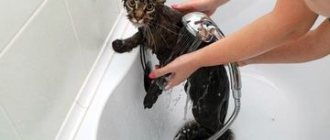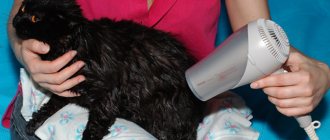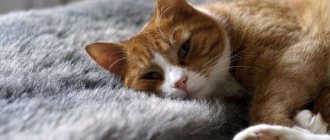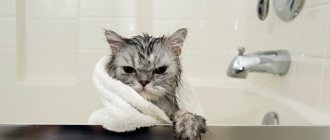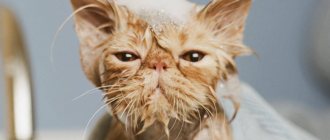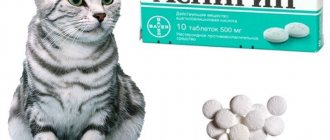Most cats avoid water treatments. However, this is one of the important components of hygiene. How correctly a kitten is bathed for the first time determines its attitude towards water for many years. Therefore, it is necessary to approach this event responsibly: choose a suitable detergent, study the advice of felinologists and, of course, be patient.
The advisability of bathing
Cats are very clean animals. They devote several hours every day to thorough licking. With the help of a rough tongue, pets are able to remove almost any dirt, as well as lost hair and skin flakes.
This desire for cleanliness has practical implications. Cats try to neutralize their own scent in order to sneak up on their prey unnoticed during the hunt.
Fear of water can also be explained. A wet pet quickly becomes hypothermic because it loses its ability to thermoregulate. Domestic cats living in “greenhouse” conditions have a rather weak immune system, which is not always able to withstand adverse factors.
If you bathe a kitten with an aggressive shampoo, the protective lubricant will disappear. Because of this, the fur becomes dry and brittle, and the skin begins to peel. Therefore, only special cosmetics are used for washing.
The kitten needs to be bathed when the following signs appear:
- the wool smells unpleasant;
- skin becomes sticky;
- abundant fatty deposits appear;
- the kitten has fleas;
- Dirt accumulates in the folds of the skin.
Cats are bathed if they are very dirty. For example, in any chemicals, soot, oil. In this case, licking the fur will cause serious harm to the health of the pet.
How to wash a cat: types of shampoos for cats
They may differ in release form, as well as in their state of aggregation. Shampoos can be:
- Dry. In the form of free-flowing powders.
- Classic. That is, the same as in humans, which must be applied to wet wool.
- Shampoos in sprays. This is a new type that does not contain moisture, so there is no need to wash your cat before applying shampoo. There's no need to rinse it off either.
Shampoos for cats
Purpose of shampoos:
- According to their action, shampoos can be cosmetic . They are used only if it is necessary to remove dirt from your pet's fur.
- Medicinal. This kind of shampoo is also divided into several types, depending on the problem. There are shampoos for ringworm, fleas, and bacterial infections. Remember that flea shampoo contains an insecticide, so such products cannot be considered completely safe. It is necessary to carefully monitor your pet to ensure that the product does not get into the eyes, ears or mouth. Because this can provoke poisoning of the animal. Anti-lichen shampoos are also often used. They contain antifungal drugs that help fight rashes.
- Antibacterial shampoo most often contains an antiseptic. In the case of a cat, most likely it is Chlorhexidine or Miramistin. The product allows you to get rid of a bacterial infection in a short period of time.
- In addition, there are special shampoos that can tint your pet's coat. That is, you can separately purchase shampoo for white and black cats. They help give a beautiful shade to the coat and also care for it. Please note that toning shampoos cannot be used before visiting the exhibition. Because your cat may be disqualified.
Shampoos for cats
Please note that under no circumstances should human shampoo be applied to the skin of hairless cats. That is, these are sphinxes, as well as Egyptian breeds that have practically no hair. The fact is that their skin is very sensitive to various kinds of substances, and dries out very much when exposed to regular shampoo.
For such cats, special products have been developed that allow you to moisturize the skin and form a protective silicone layer on its surface, which prevents the penetration of microorganisms, as well as flaking of the skin.
Bathing a kitten
Contraindications to bath procedures
There are situations when it is absolutely forbidden to bathe kittens. These include:
- Illness - avoid water procedures until complete recovery.
- Vaccination – bathing kittens is prohibited for 14 days after vaccination.
- Ringworm - along with water, the infection will spread to other parts of the body.
- Surgery – After surgery, cats are not bathed until the stitches have healed.
- Severe stress - water procedures will only aggravate the condition.
Preparing for a swim
Half the success is quality preparation, especially when it comes to training an adult cat that has not yet experienced the “joys” of water procedures. You will need:
- 2 shallow but wide basins for water.
- Comb with large rounded teeth.
- Sponge.
- Capacity for pouring up to 250 ml in volume.
- Large bedspreads or sheets.
- Several thin ones and one bath towel.
- Gloves and thick clothing to protect the body.
- Water thermometer.
- Shampoo, if necessary.
- It’s very good if there is a “second pair of hands” to help.
Important! The cat should not be tied up while bathing. If your pet panics, he may hurt himself with the collar or leash.
At what age can you bathe a kitten?
Kittens are more vulnerable than adult animals. Their immunity is still developing, so you shouldn’t risk bathing your pet too early. During washing, the temperature regime is disrupted and the fatty film that protects the baby from pathogenic bacteria is washed off.
There is no need to bathe kittens for the first 2 months after birth. The mother takes care of their hygiene. However, many breeders wash kittens as early as 1 month. This is due to the fact that they prepare animals for sale and try to provide the kids with the most attractive appearance.
In case of severe contamination, you can carefully wash a one-month-old kitten, but only if it is accustomed to its owners and has become comfortable in the apartment. If possible, it is better to limit wiping with a damp cloth.
At 3 months, when the kitten is stronger, you can start bathing it without harm to its health. There is no need to postpone the procedure. The sooner the baby gets acquainted with water, the sooner he will get used to it.
As for at what age you can bathe a kitten with flea shampoo, it largely depends on its brand. Typically, such drugs are not used for up to two months.
However, some mild flea shampoos can be used a little earlier. It is better to consult a veterinarian first and carefully study the instructions.
How to bathe a cat who is afraid of water?
What to do if the cat doesn’t really like to swim? Indeed, almost all pets do not like to bathe. Accordingly, the entire procedure of bathing a cat can become a real test for the whole family. This is due to the fact that the cat can meow, struggle, scratch, and try in every way to prevent bathing. How to calm the animal and wash it properly?
Many pet owners insist on purchasing dry shampoo. It comes with a mixture that is very similar to powder or talc. It is necessary to sprinkle this product onto the cat's fur and rub thoroughly. After this, take a brush and carefully comb out the fur. After this, the cat does not need to be washed or rinsed off with water. This shampoo contains an adsorbent that perfectly absorbs dirt, grease, and unpleasant odors. Accordingly, after this kind of procedure, the cat will feel like after a bath. Of course, it is best to wash your cat as usual using a special shampoo.
Afraid of water
Instructions for the procedure:
- Do not spray your cat with water from a hose or shower. A strong jet can frighten a pet and it will begin to panic.
- Fill the bathtub with water equal to half the cat's height. That is, the water should reach approximately to the beginning of the chest. Please note that the water temperature should be slightly warmer than when people swim.
- Since a cat's body temperature is slightly higher than that of a human. Next, you need to wet the cat's fur. To do this, it is not necessary to pour large quantities of water onto the animal. It is enough to wet your palm, thus moisturizing the fur.
- Please note that a slippery bath may frighten your pet. We recommend placing a silicone or rubber mat on the bottom of the bathtub. This will prevent slipping. Next, you need to apply a special shampoo, thoroughly lather it on the animal’s fur, and rinse with plenty of water.
- Next, you need to wrap the cat in a towel and take it to a warm place without drafts. Please note that animals can get very cold due to the fact that there is no air cushion, which is typical for cats if they are dry.
- Therefore, try to dry the cat with a towel, and even use a hairdryer. Although many owners do not recommend using this device, since some of their pets are afraid of the noise of the hair dryer. But this will help dry the pet faster.
Pending
How often to wash
Cats' natural love for cleanliness makes bathing an auxiliary, rather than a primary hygiene procedure. On the contrary, too frequent washing degrades the quality of the fur.
The frequency of washing kittens depends on the breed, coat length, and health status. As a rule, cats are bathed 6 times a year. If the animal does not leave the apartment, bath days are held once a quarter or six months.
Often you can only wash kittens of hairless breeds. They get dirty faster, so they get water treatments about once a month. Show cats are given unscheduled baths before shows.
For your information. If a cat goes outside, be sure to wash its paws after each walk.
How to wash a kitten
Kittens are bathed using gentle products. Shampoos are not suitable for people - they are too aggressive.
Manufacturers produce cosmetics for a specific skin type:
- dry;
- fat;
- normal;
- damaged.
The most common are liquid shampoos and conditioners. They can contain both regular cleaning agents and special components. For example, to kill fleas, ticks and other parasites.
There are other types of cat shampoos:
- Dry shampoo is in powder form. Contains absorbent components: they remove excess sebum and dead skin flakes. However, it is not able to cope with heavy pollution. Used as an express remedy for show pets or kittens that are afraid of water. Suitable for use in winter as it avoids hypothermia.
- Spray shampoo - works almost the same as dry shampoo. Moisturizes and conditions the coat, helps get rid of tangles. A good option for partial bathing, when you just need to refresh your coat.
Some owners use a mixture of baby powder, cornstarch or baking soda as dry shampoo. However, this is quite risky. By absorbing moisture, starch releases gluten. If water gets on the skin, it will swell and stick to the fur.
It will most likely not be possible to comb it out - the animal will still have to be washed. The soda must be carefully removed, otherwise the cat will be poisoned by eating it while licking it.
Important. It is better to bathe animals using industrial dry shampoos. For example, brands Trixie Trocken and Mr. Gee.
When choosing a detergent, you need to take the following points into account:
- Short-haired, long-haired and hairless kittens are bathed with shampoos from separate lines.
- You should buy shampoos designed specifically for cats, or at least for cats and dogs. However, some show cosmetics are only made for dogs. It is used in extreme cases.
- Concentrated shampoos are more expensive, but are more economical. Before use, they must be diluted with water according to the instructions.
The most popular cosmetics that can be used to bathe a kitten are presented in the table.
| Effect | Name |
| Against parasites | “Disinfectant” (Bioflor company); |
| "Lugovoy" (Agrovetzaschita); | |
| “Tar” (Clandestine); | |
| "Doctor ZOO" | |
| Medicinal | "Doctor" (Goodman); |
| "BioVax for kittens"; | |
| Beaphar Shampoo Anti Dandruff | |
| For damaged skin and coat | Iv San Bernard Zeolithe |
| Strengthening and restructuring the coat | YuuP! Professional Restructuring & Strengthening; |
| Tropiclean Lime/Coconut | |
| To regulate shedding and against tangles | FURminator spray; |
| Perfect Coat Shed Control & Hairball (8 in 1); | |
| Phytoelite (Veda) | |
| Caregiver | Iv San Bernard Atami (antistatic); |
| “Gentle”, “Marine” (Agrovetzaschita); | |
| “Velvet” (CrystalLine); | |
| Artero 4Cats | |
| To add volume | Anju Beaute Texture Volume |
Important. The kitten may be hypersensitive to some component of the detergent. Therefore, after bathing you need to monitor the baby’s condition. If an allergy occurs, you should contact your veterinarian.
The ABCs of Bathing
Considering the risks that water treatments can cause to animals, they should be approached responsibly. Any deviation from the rules can lead to dermatological or colds.
First bath
In order not to traumatize the baby’s psyche, the first water procedure should be as comfortable as possible. The quality of its implementation determines the attitude towards subsequent bathing.
You need to get used to water from an early age. At 3 months, the kitten can already have a bath day. Before this, responsibility for the cleanliness of the pet lies on the mother's shoulders. If he is very dirty, he can be given a bath even at 1 month of age.
The first bath is carried out when the kitten reaches 3 months.
Frequency of bathing
Considering the love of the feline family for cleanliness, washing should be an auxiliary activity, but not the main one. Frequent bathing has a negative impact on the condition of the coat.
It is advisable to arrange scheduled washing no more than once every 6 months. Some cat owners reduce this time period to 4 times a year.
The frequency of water treatments depends on the breed of the pet, the condition of the hair, the presence of parasites and lifestyle. Hairless cats, for example, should be washed more often than long-haired cats. Those who like to spend time outdoors are bathed up to 6 times a year, unlike those at home. Before participating in exhibitions, unscheduled swimming is possible. In addition, animals need to clean their paws every time after being outside.
The frequency of bathing for free-range cats is once every 2 months.
General recommendations
Before you begin water procedures, you need to familiarize yourself with the advice of experienced cat owners and veterinarians. To make this event comfortable and not cause harm, it is advisable to adhere to the following rules:
- Wash on an empty stomach or after a small snack.
- Avoid contact with water for 14 days after vaccination or if you have ringworm.
- It is advisable to adjust bathing to seasonal molting. During this period, pets lick themselves more often, which is fraught with accumulation of hair in the stomach and disruption of digestive processes.
- Pedigree animals are given unscheduled baths before participating in exhibitions.
- If the cat is very dirty and is unable to cope on its own, an additional bath day is arranged.
Some owners use the services of groomers for their first bath. Such a service costs about 400-600 rubles and allows you to learn all the intricacies of the procedure.
Long-haired cats should be bathed during shedding.
Strategically important places
Some parts of kittens' bodies get dirty more than others. During the bathing process, special attention should be paid to the following areas:
- armpits;
- behind the ears;
- stomach;
- paws;
- anal area.
Animals' ears also get very dirty, but they can be cleaned with cotton swabs.
Cats have highly sensitive paws equipped with sensory organs. Nerve receptors help them hunt and maintain balance. They react very sensitively to any changes in the environment, including temperature. Too cold or hot water can cause severe pain in your pet.
Paw pads are considered one of the most sensitive places on a cat's body.
Detergents
The kitten hair care line is presented in several versions - shampoos and conditioners for normal, dry, oily and damaged skin. Since kittens have more delicate skin and fluffier fur than adults, they need gentle products.
Based on consistency, washing cosmetics are divided into 3 groups:
- Liquid. This category includes soap-based shampoos and conditioners. Most in demand.
- Powdery. Indispensable for pets afraid of water. Applying cleansing powder is more labor-intensive, but relieves the kitten from a stressful situation. Not suitable for animals with dark fur.
- In the form of sprays. A convenient sprayer allows for precise application of the product. Helps with partial bathing and for working with tangles.
Dry shampoo can be made at home. To do this, mix equal parts baby powder and cornstarch.
8in1 Waterless Cat Shampoo Spray - popular waterless shampoo
Table 1. The best shampoos for bathing kittens
| Direction | Shampoo name |
| Antiparasitic | “Disinfectant”, “Lugovoi”, “Tar Celandine”. |
| Medicinal | "Doctor", "BioVax". |
| During molting | Yuup Restructuring and Strengthening, Tropiclean. |
| Dry | Trixie Trocken Shampoo, Mr. Gee. |
| From tangles | FURminator anti-tangle spray, Perfect Coat Shed Control and Hairball. |
| Carers | Iv San Bernard Antistatic, “Gentle”, Artero 4Cats, “Marine”, “Velvet”, Artero Basic. |
| To add volume | Anju Beaute Texture Volume. |
The use of volumizing products is not recommended for Siamese kittens.
Rules of application:
- When choosing detergents, you should take into account the type and color of the coat, as well as the condition of the skin.
- Shampoos for long-haired kittens are not suitable for pets with short hair and undercoat.
- Detergents have different PH levels, which directly affects the silkiness and grooming of the coat. If for humans they are designed for an acid-base balance of 3.5 to 4.5 units, then for cats you need to look for products with a pH of 6.5.
- It is preferable to buy concentrated shampoos. They are more expensive than regular ones, but they are more economical in consumption.
- Herbal shampoos are not used for silver, white and blue kittens.
- Siamese and Abyssinian babies are not recommended to use care products to create volume.
- You need to purchase specialized products designed for cats or for cats and dogs. The use of exclusively dog shampoos is possible only before participating in exhibitions.
- Most detergents need to be left on the wool for up to 7 minutes. This is especially true for medicinal products.
- It is not advisable to use 2-in-1 shampoo-conditioners.
- Human cosmetics are not suitable for kittens because they kill the skin's defenses.
The best conditioners for bathing babies are those produced by Tropiclean and Iv San Bernard.
Iv San Bernard is a popular Italian brand among groomers
How to properly bathe a kitten for the first time
If you bathe a small kitten correctly for the first time, he will not develop negative associations with this procedure. Therefore, it is so important that washing is as comfortable as possible.
Felinologists recommend adhering to the following rules:
- Do not bathe your cat after eating. Only a light snack is acceptable, but it is better to wash your pet on an empty stomach.
- It is advisable that the kitten bathe during the molting period. Washing will make the process easier, and the animal will not accumulate a lot of hair in its stomach.
- Before bathing your pet, carefully comb the fur coat and untangle the tangles. To prevent the kitten from scratching, it is advisable to shorten the claws.
- The bathroom should be protected from drafts.
- To wash your kitten for the first time, it is better to use unscented shampoo.
- At first, it is better to bathe the kitten with an assistant. One person will hold the baby, the other will perform the necessary manipulations.
- The water should not be too cold or hot. Optimum temperature +38…+40°C.
- The ears are plugged with cotton to prevent water from getting into them. If this happens, inflammation may develop.
- It is better to wet your head not with a stream of water, but with a damp sponge.
It is recommended to wash the kitten for the first time not in the bath itself, but in a small basin. This will make it easier to hold him, and the pet will feel more confident. To prevent the paws from slipping, place a rubber mat on the bottom of the container.
For your information. It is not advisable to bathe a kitten in a sink. He can escape, fall from a great height and get injured.
All necessary equipment - detergent, towels, treats, etc. - should be at hand. If your pet scratches a lot, you should take care of rubber gloves. They will protect your hands from sharp claws.
When all preparations are completed, the kitten is gradually immersed in water approximately up to the shoulders. You can allow him to hold on to the edge of the basin and at the same time pour water on him. To bathe your pet without scaring it, talk to the baby in a gentle voice during the process. A friendly intonation makes it clear that there is no threat.
Shampoo is diluted in a separate container in the required concentration and applied to the kitten’s body. The soap solution is carefully distributed with massaging movements, being careful not to wet your head. Particular attention is paid to:
- armpits;
- stomach;
- areas around the genitals;
- paws;
- places behind the ears.
More dirt accumulates here. If your pet is bathed with an antiparasitic agent, the neck is treated first to prevent fleas from escaping to the head.
Leave the shampoo on the fur for the time specified in the instructions, and then rinse the kitten with plenty of water. It is better to water the baby from a mug or wet the fur with the palm of your hand than to use a tap or shower - a powerful stream will scare the pet.
At the end, the fluffy is generously praised and treated to his favorite treat to reinforce positive associations.
Instructions for bathing a kitten
The main principle that should be followed when washing your baby is not to scare him. This is especially important for 3-month-old kittens. The first procedure affects the subsequent attitude towards water. The resulting negative experience can permanently discourage the desire to swim.
Step 1. Preparatory stage
Due to the fact that cats perfectly recognize the emotional state of the owner, you should relax before bathing. The owner's nervous mood is transferred to the animal.
General recommendations:
- Check that there are no drafts in the bathroom.
- Cover your baby's ear canals with cotton balls. Getting water into the ears can lead to colds. It is advisable to lubricate the corners of the eyes with Vaseline. This will help prevent shampoo from getting on mucous membranes.
- Trim the animal's claws and brush it. If there are tangles, they need to be removed.
- Prepare a towel, gloves, shampoo, conditioner, your kitten's favorite toys and, if necessary, a basin.
It is better to prepare for this event on your own, without the presence of the kitten.
Your pet's overgrown nails should be trimmed before bathing.
Step 2. Selecting a container
A large bath is not suitable for washing a kitten. It is better to use a basin or sink. During the procedure, the baby should stand on his feet and not swim. In addition, it is easier to hold it in a small container. To prevent the paws from sliding on the surface, the bottom should be covered with a rubber mat.
Step 3. Water procedure
When immersing a kitten in water, you should make sure that it does not rise above the shoulder line. The optimal temperature is from 36 to 39°C. It is necessary to hold the baby tightly to prevent him from jumping out. During this event, it is advisable to constantly talk to your pet and distract him with rubber balls, soap bubbles and other improvised means.
Basic Rules:
- Dilute shampoo and conditioner not on the animal’s fur, but in a separate container.
- Carefully remove the foam formed on the hair using a special brush.
- Do not spray your baby with tap water or shower water. It is preferable to rinse from a mug.
- Pay special attention to the areas behind the ears, on the paws, groin, anus and abdominal area. The most dirt accumulates in these parts.
- Apply water to the kitten's head using a sponge. This will prevent water from getting into your ears.
- Rinse off detergents thoroughly. Otherwise, the animal may be poisoned. To wash away the smell of care products, cats lick themselves thoroughly after washing. If shampoo left on the fur gets into the digestive tract, it will cause stomach upset.
- If the pet is very dirty, before bathing, grease the stain with butter and blot it with a napkin.
- When using anti-parasitic flea products, the neck should be blotted first. This helps prevent insects from migrating to the head.
- If there is a need to wash individual parts of the body, use wet wipes, a towel and spray shampoos.
At the end of the procedure, reward your baby with his favorite treat.
A cat's body temperature is 38 degrees, so the water temperature should not be more than 39°C
Step 4. Drying the wool
At the end of the procedure, you need to blot with terry cloth and wrap in a softer towel. This will help avoid the occurrence of colds. You should not rub your pet, as there is a risk of tangles forming. To prevent your pet from getting sick, he should spend the next 12 hours in a warm room. Staying in the fresh air is not advisable.
Some babies love to blow dry their hair. However, this device is only suitable for long-haired breeds. During the drying process, comb the hair. This prevents the fur from tangling and removes dead hair.
If a kitten trembles for more than 5 minutes after bathing, regardless of breed, it should be dried with a hairdryer. Otherwise, pneumonia may develop.
Signs of pneumonia in cats
How to wash representatives of different breeds
Representatives of different breeds require a special approach to bathing:
- Shorthaired Scots and Britons who devote a lot of time to grooming can be bathed once every six months.
- Long-haired cats, such as Persian or Siberian cats, need to be washed every 2 months.
- White kittens are bathed with whitening shampoos.
- Detergents for long-haired breeds are not used for short-haired kittens with abundant undercoat.
- It is not advisable to bathe kittens of white and blue colors, particolors and silver pets with herbal shampoos.
- To wash Sphynxes and other hairless cats, specialized shampoos are used that care for the skin. The head is wiped with sanitary napkins.
- Products for adding volume are not suitable for animals with tight-fitting hair without undercoat (Siamese, Oriental, Abyssinian cats, etc.).
Popular shampoos for bathing cats: review
List:
- Shampoo Doctor . This product contains benzoyl peroxide, which exhibits antifungal, antiviral, and antibacterial properties. Thanks to this, it gets rid of dandruff and also prevents the occurrence of lichen in cats. Can be used for cats of any breed.
- Shampoo Elite . This option applies only to hairless cats, that is, hairless ones. The composition contains many herbal extracts: thyme and eucalyptus, which help regulate the secretion of sebum and also prevent dry skin. Forms a kind of film on the surface that protects the pet’s sensitive skin.
- Perfect coat. An excellent product that reduces hair loss. Best prevents the formation of tangles in your pet’s stomach. In addition, the shampoo is anti-allergenic and can be used for bathing pets who suffer from allergies.
- Jerob shampoo . This is a professional product that is mainly used to prepare pets for exhibitions. Helps improve the condition of the coat, making it fluffy, smooth and shiny. The cost of the shampoo is quite high, so if you have an ordinary pet that does not participate in exhibitions, there is no point in purchasing this shampoo.
- Rolf Club . This is a whole line of cat care products. The fact is that these shampoos may contain completely different components. The line consists of shampoos for long-haired breeds, short-haired ones, and also with medicinal effects. They help get rid of lichen, fleas, and various bacterial lesions. Prevents the formation of dandruff, as well as excessive drying of the cat's skin. Choose the type of shampoo depending on the cat's breed, as well as the specific problem.
- Biovax shampoo . Contains Lanolin, which prevents your pet's skin from drying out. That is, the hairs are covered with natural wax, which gives the coat shine and a healthy appearance. Almost all animals are not allergic to this product, because there are very few allergens in the composition.
Shampoo for cats
For bathing, it is best to purchase shampoos at a veterinary pharmacy or special pet stores. They have a special composition and do not dry out the cat’s skin at all.
How to teach a kitten to bathe
Bathing is a serious stress for your pet. To avoid health problems and not to injure the baby’s psyche, he needs to be prepared before the first wash.
Important. Kittens subtly sense people's moods. If the owner is nervous, the anxiety will be transmitted to the pet. Therefore, before swimming you need to calm down and relax.
First, the kitten is placed in a dry bath and they try to play with it. He needs to understand that it is safe here. When the baby gets comfortable, open the tap. Some pets themselves show interest and begin to play around with a thin stream of water.
The process is repeated several times until the kitten becomes absolutely calm about the procedure. Cats that cannot get used to water can be bathed in mesh bags. They restrict the movement of animals, but do not prevent water and detergents from entering the body.
At what temperature should you bathe adult cats?
You need to wash your cat in warm water. It is unacceptable for it to be cool or hot.
This is explained by the fact that this pet is sensitive to hypothermia or overheating.
Determining that the liquid temperature in the bath is comfortable is quite simple.
You need to put your elbow in it. If the water is lukewarm and not scalding, you can safely wash your cat in it.
How to dry
After bathing, the pet is dried with a terry towel and wrapped in a soft cloth. You should not rub the fur vigorously - it will become very tangled.
Then the kitten is released. He begins to actively lick himself and dries his coat on his own. The rough tongue combs the hairs and evenly distributes protective lubricant over them.
If your baby trembles for more than 5 minutes after bathing, you should use a hairdryer. The same applies to long-haired breeds. However, the baby must first be introduced to this device, otherwise he will be scared. The air flow should be warm, but not hot. During the drying process, the fur is combed in the direction of hair growth.
Important. For 12 hours, the kitten should be in a warm room without drafts and not go outside.
If you bathe a kitten correctly, it will not be afraid of water. It is important to teach your baby hygiene from childhood and use suitable detergents - then the procedure will not cause much trouble.
Is it possible to bathe a kitten
Many happy owners of kittens have a reasonable question whether they can be bathed and whether this procedure will harm the babies. In the first weeks of life, there is no point in bathing, since every mother cat diligently monitors the cleanliness of her babies and often licks their fur. In addition, for very small kittens, temperature changes during the bathing procedure can be unsafe for health.
The sooner you start accustoming your kitten to water procedures, the easier it will be for him to tolerate them as an adult.
When the kitten grows up a little, he already looks after himself, so he is able to keep himself clean. But, nevertheless, most kitten owners, including professional breeders, agree that kittens still need to be bathed. But you shouldn’t be overzealous with water procedures.
For your information! The optimal age to start active bathing is the period when the baby's baby teeth change.
